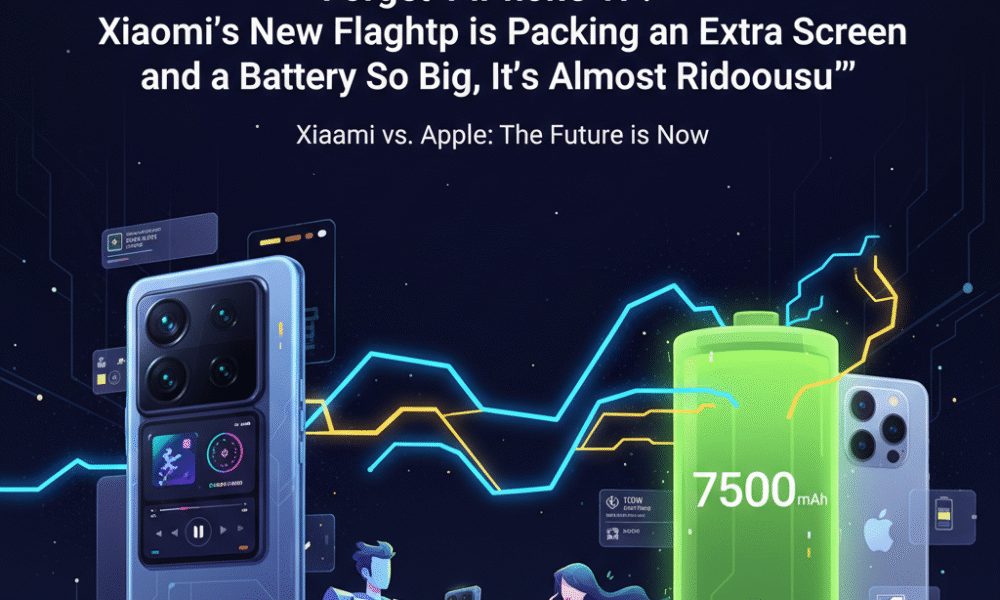Forget the iPhone 17 PRO MAX Xiaomi’s New Flagship is Packing an Extra Screen and a Battery So Big, It’s Almost Ridiculous

Apple just dropped its iPhone 17 series, and sure, they look sleek. But over in Xiaomi-land, they’re not just playing catch-up; they’re inventing a whole new game. The buzz around the new Xiaomi 17 Pro Max isn’t just about another high-end phone – it’s about two jaw-dropping features that make you wonder if Apple’s been napping: a legitimate extra screen on the back and a battery so huge it laughs at your power bank. Is this Xiaomi’s moment to truly challenge the iPhone’s crown? Let’s dive in.
1. Two Screens Are Better Than One: Xiaomi’s Back-Display Bonanza
- What’s the Big Deal?Imagine a world where the back of your phone isn’t just a canvas for fingerprints and camera lenses. The Xiaomi 17 Pro Max dares to imagine precisely that, equipping its rear with a fully functional secondary screen. It’s a bold proposition – a fundamental rethinking of how we interact with our devices.
- A Trip Down Memory Lane (Xiaomi Edition):The seeds of this idea weren’t sown overnight. Xiaomi first flirted with the concept back in 2021 with the Mi 11 Ultra, which featured a diminutive 1.1-inch AMOLED display beside the cameras. While primarily intended for enhanced selfies using the superior rear cameras and quick notification glances, it felt like a tantalizing glimpse into a potential future. Then, silence. The following iterations, the Mi 12S Ultra and Mi 13 Ultra, conspicuously lacked this feature, leaving many to wonder if it was merely a passing fancy, a technological dalliance. But Xiaomi’s patents, showcasing designs for wrap-around and sliding screens, suggested a deeper, more sustained interest.
- The Comeback Kid: Xiaomi 17 Pro Max’s “Magic Back Screen”Now, the prodigal screen returns, reborn and amplified on the Xiaomi 17 Pro Max. Dubbed the “Dynamic Back Display” or, more playfully, the “Magic Back Screen,” this isn’t a token gesture. We’re talking about a 2.9-inch, high-resolution, 120Hz AMOLED panel. This is a screen meant to be used.It’s not just for vanity shots, though high-quality rear-camera selfies are undoubtedly a perk. The screen serves as a hub for music controls, interactive widgets, and even countdown timers. And, in a stroke of nostalgic genius, Xiaomi is offering a special Game Boy-esque case that enables light gaming on the rear display.
- Gimmick or Genius? The Great Screen DebateThis is where things get interesting. The possibilities are undeniably exciting: unparalleled selfie quality, glancing at information without fully engaging with your phone, and a healthy dose of “wow” factor.However, legitimate concerns arise. Does this added screen compromise the phone’s sleekness? Does it introduce another vulnerable surface prone to cracking? Will developers embrace this feature, or will it languish as a novelty? And, perhaps most practically, how will one find a case that adequately protects this dual-screen marvel?
- How Apple Compares (or Doesn’t):Apple has favored a more subtle approach to expanding screen functionality. The Dynamic Island, that clever morphing notch, and the Always-On display represent Apple’s incremental, software-driven additions. The most significant “external screen” speculation revolves around the long-rumored foldable iPhone (iPhone Fold), anticipated in 2026, which would necessitate a cover screen. Xiaomi is challenging the status quo now.
2. The Unholy Power: A Battery That Just Won’t Quit
- Why So Big?In our hyper-connected world, our smartphones are demanding mistresses. Their vibrant displays, lightning-fast processors, and ubiquitous 5G connectivity drain power with alarming alacrity. A bigger battery isn’t a perk; it’s an increasingly vital necessity.
- Xiaomi’s History of Power-Pushing:Xiaomi has been a relentless innovator in battery technology and charging speeds. From the relatively modest 18W charging on the Mi 3 in 2013, they rapidly escalated.Who can forget the 120W HyperCharge on the Mi 10 Ultra (2020)? It could replenish a 4500 mAh battery in under 30 minutes. Then, they demonstrated 200W wired charging (a full charge in a blistering 8 minutes) and a mind-boggling 300W (4100mAh in 5 minutes!). These feats pushed the very boundaries of what we considered feasible.
- Xiaomi 17 Pro Max: Battery Behemoth!The Xiaomi 17 Pro Max doesn’t simply offer a large battery; it boasts a gargantuan 7,500 mAh cell. This is not just “big”; it’s verging on the absurd, promising battery life that could potentially span days. The standard Xiaomi 17 and 17 Pro don’t slouch either, offering 7,000 mAh and 6,300 mAh, respectively.The Pro Max supports 100W wired charging and 50W wireless charging. And, a notable feature – the series uses silicon-carbon batteries and the Surge Battery tech which contains a G2 management chip.
- The Dark Side of Power: Trade-offs & WorriesFast charging, while convenient, places stress on battery chemistry. Xiaomi acknowledged that their 200W technology resulted in a 20% degradation after 800 cycles. And, like the vast majority of modern smartphones, the batteries are non-removable, contributing to e-waste.The most immediate concern is bulk. Can a 7,500 mAh battery be integrated into a sleek phone without transforming it into an unwieldy brick? Xiaomi asserts that the 17 series maintains a slim 8mm profile, so the company has definitely optimized.
- Apple’s Battery Game:The iPhone 17 Pro Max features Apple’s largest battery to date, clocking in at 5,088 mAh. While a significant upgrade, it remains considerably smaller than Xiaomi’s offering.Apple’s charging speeds, while improved, still lag behind Xiaomi’s aggressive rates. Apple prioritizes software optimization (Adaptive Power, battery health monitoring) and energy-efficient chips.
3. Clash of the Titans: Xiaomi vs. Apple in the High-End Ring
- Apple’s Playbook:Apple’s strength lies in its refined design, seamless ecosystem, and a user experience predicated on the principle that “it just works.” They typically introduce features only when they are thoroughly polished, relying on brand loyalty.
- Xiaomi’s Gauntlet:Xiaomi adopts a different tack: aggressive innovation, pushing the envelope with cutting-edge technology, often at more competitive price points. Their sights are set squarely on Apple’s premium market, and their recent growth in high-end shipments indicates that this strategy is resonating with consumers.
- The Core Question:Is Xiaomi merely engaging in a “spec war,” or are these features genuinely enhancing the user experience? Is Apple playing it too cautiously, or is its focus on seamless integration ultimately more impactful?
4. The Future is Now (and Beyond)!
- More Screens Everywhere:Xiaomi will continue to refine its rear display, possibly enabling full-screen applications or more sophisticated interactive widgets.Apple’s foldable iPhone will inevitably inject new life into the “two-screen” conversation. The lines between “secondary” and “cover” screens will inevitably blur.
- Battery Revolution:Xiaomi is already deeply invested in silicon-carbon batteries. Solid-state batteries, currently being developed for their electric vehicles, may eventually find their way into smartphones, promising even higher energy densities and faster, safer charging.Apple is also exploring new battery materials. Solid-state battery rumors continue to surface.
- The Unending Race:The pursuit of greater screen real estate, longer battery life, and faster charging will never cease. AI will play an increasingly pivotal role in optimizing every aspect of our devices, enhancing efficiency.
So, Should You “Forget the iPhone 17”?
The Xiaomi 17 Pro Max is a serious contender, boasting a versatile secondary screen and a battery that promises unrivaled endurance. If you’re seeking cutting-edge technology and liberation from charging anxiety, Xiaomi presents a compelling argument. The iPhone 17 will undoubtedly offer a refined experience, but Xiaomi is making its case as the bolder, more experimental innovator.
Ultimately, the choice rests with you: Apple’s refined consistency, or Xiaomi’s audacious leap into a multi-screen, mega-battery future?

